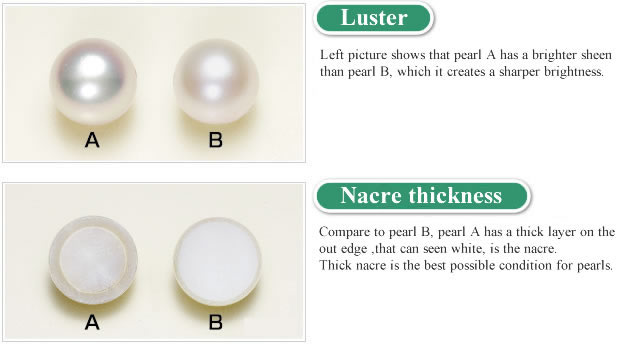The most important thing about pearls is the luster, a shine with a color.
If there is an above certain nacre, pink or green substance color can be seen by the action of the luster.
When the crystals which form pearl layers are finely piled, the pearl will brightly shine from the top area.

Pink and green color seen with the sharp bright of the pearls is the best possible condition for pearls.
Pearl clinic check the luster and the nacre by using the machine.
Do you know how to recognize imitation pearl?
①Let's rubbing.
②Let's take a look at the size of the hole of the necklace.
③Let's weighed by hand.
④Let's check an align of pearl.
The color of pearls can be classified by interference and substance color.
Interference color: coloring matter included in protein to create the pearl layers (black or yellow)
Substance color: created by the action when the light penetrates and reflects the pearl layers (same action as the rainbow color of soap bubble)

■ Action of the luster
Protein
Calcium carbonate
Like the beautiful color of the pearls in the picture above has created by the double color of interference and substance.
There is no best color in general for pearls but it is up to personal preference.
Choose the suitable color depending on the scene and purpose.
Pearl clinic offer you a product which meets your requirement.
When it comes to looking for a pearl, it is key to exanine its nacre thickness, luster, color, shape and size. We would like to focus on the nacre thickness and the luster of the pearls. When foreign particles enter the mollusks, the oyster will internally try to secret the same components as the inner lining of its shell and integrate and wraps itself around these particles which eventually become a pearl. (The particles that are integrated are called “nacre” and this is what encases around the foreign objects.) When we look at the pearls, we can determine the thickness or thinness of the nacre thickness. However, it is considered that the thicker the nacre thickness is, the deeper and more luster the pearl has. Every year, the nucleating process is carried out between the seasons of spring and summer, however the pearls that are extracted that winter is called a “one year pearl,” whereas the pearl that has been extracted the winter before is known as “the crossovers.” These “crossovers” have a higher tendency to have a thicker wrap and a more beautiful luster; however, a much more meticulous management of the mollusks is required and the volume of harvest is relatively scarce.









